Nifty farm machinery innovations at Canada Agri-Trade Expo
Paralysing cold and head-high snowdrifts send Canadian farmers retreating to their workshops over winter, and several of the implements they have built or modified were on show at last month’s Agri-Trade exhibition in Red Deer, Alberta.
See also: Revealed: Britain’s biggest farm machinery dealers
Devloo Roto mud scrapers
Manitoban farmers Mark and Gerry Devloo have developed a means of reliably peeling claggy soil from the press wheels of a drill.
The spinning metal cups that form their Roto Mud Scrapers should help maintain a consistent sowing depth and avoid potentially metal-bending bung-ups in less favourable conditions.
Each row unit is carried on its own custom bracket designed to fit specific drill models.
Primarily, these are for North American brands such as Bourgault, Salford and Seed Hawk (owned by Vaderstad), but the father-and-son team is gradually widening its offering to machines available in Europe.
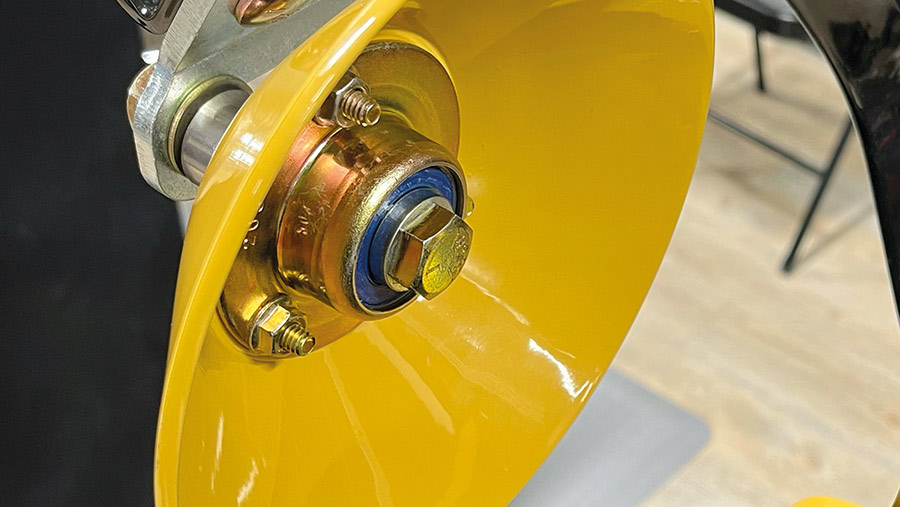
© MAG/Oliver Mark
So far, this includes the Cross Slot, Amazone Condor and Horsch’s Sprinter.
The cups themselves vary in size too, with diameters from 7in (178mm) to 11½in (292mm) to suit the width of the press wheels.
Because of their slightly offset mounting point, the wheels start spinning the cups as soon as enough soil has accumulated to fill the 3mm gap between the two.
This, the firm says, results in uniform emergence, allows the drill to operate in wetter conditions and reduces tyre drag, smearing and tractor fuel consumption.
They are also said to last as long as the drill, thanks to their powder-coated finish and, in part, to the protective skin of dirt that forms over the paintwork.
Each unit costs C$170 (£108), including the mounting bracket.
Arnold Innovations AI100 Reverser
British expats Richard, Annette and Douglas Arnold have developed a means of quickly unplugging a blocked combine threshing drum – saving a lot of sweating and swearing in the process.
Rather than using a long bar and plenty of elbow grease, their AI100 Reverser system employs a hydraulic ram to power the ratchet head.
To work it, the operator must first lower the concave, open the stone trap and fit the ratchet to the cylinder shaft. Power is provided by an oil supply diverted from the feeder house reverse circuit.
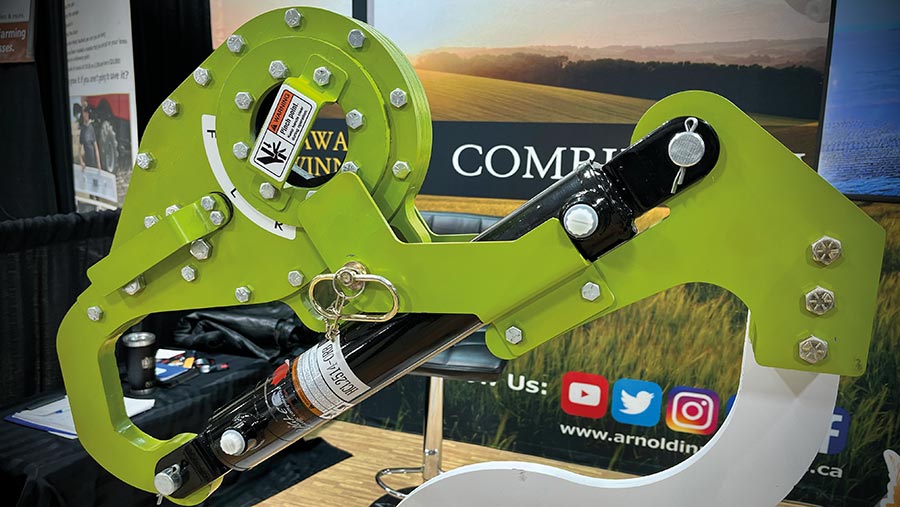
© MAG/Oliver Mark
Once in position, the mechanism can be “locked” and the spool valve operated to rock the cylinder back and forth.
This will gradually break up and free the slug of jammed material before “reverse” is selected – at which point the ram can work through its full 14in stroke to ratchet the drum around until the blockage is gone.
When not in use the ratchet unit is stashed in a cradle on the side of the machine.
The system is available for various New Holland, Claas and John Deere combine models and typically costs C$4,950 (£3,145). This includes all the pipework for installation – a job that can be done on-farm relatively easily.
In most cases it fits to existing bolt holes; the only exception is the Lexion version, for which three half-inch holes must be drilled into the main frame.
FarmArm wireless tractor control
Finding and paying someone to sit mindlessly manning a static tractor on slurry pumping or grain drying duties could be a thing of the past thanks to Pawlution’s button-pressing, lever-pushing and key-turning robotised FarmArm.
The clever console features a series of actuators that sit over the existing controls to replicate human finger movements.
This means there is no need to hack into the tractor’s complex Canbus system and mess with the electronics, which risks invalidating any warranty.
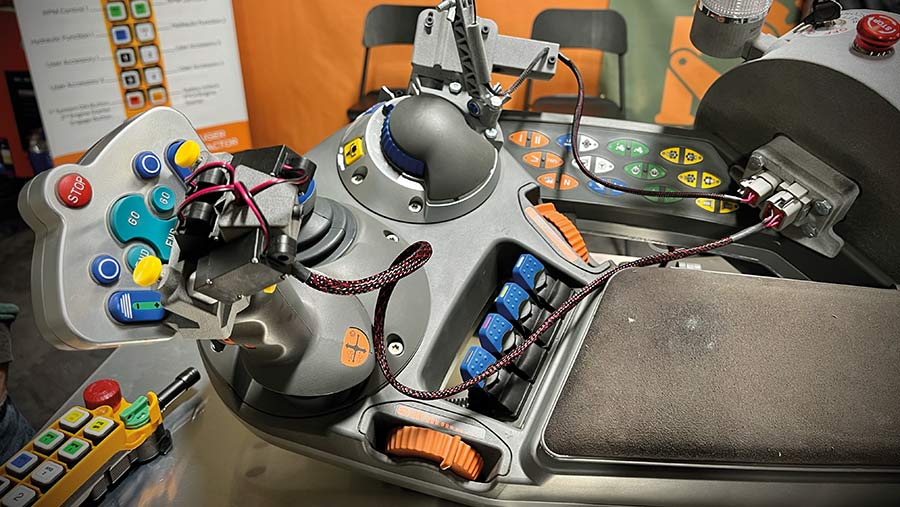
© MAG/Oliver Mark
Remote-control handset
The accompanying remote-control handset allows owners to turn the engine on and off, start and stop the pto (to a preset speed), operate two hydraulic valves and alter engine rpm.
For safety reasons, firing up the tractor and engaging the pto drive require two buttons to be pressed simultaneously, and thwacking the mushroom-headed emergency stop retracts all the actuators to their “off” position and kills the engine.
The same happens if there’s a loss of 12V power, though the kit does come with a backup battery fitted in the cab to ensure the system still works should the tractor’s alternator pack up.
Installation takes a matter of minutes, the company says, and doesn’t require the drilling, cutting or general butchering of any interior trim. Power is supplied from a standard accessory power point in the cab.
The current catch is the operating range of the remote, which is limited to about 100m. But Pawlution is working on extending that to fulfil requests from those pumping slurry over longer distances.
The FarmArm is currently available in 22 configurations to suit the layout of controls on specific tractors.
These include various John Deeres, from the vintage 4440 to the 7000, 8000- and 9000-series, plus Case IH Maxums, Pumas and Quadtracs built between 2011 and 2020 and several Fendt, New Holland and Claas machines.
However, it can be customised for any model, which Pawlution is happy to do once it receives five such requests.
These are designed on CAD software and then produced using a 3D printer at the company’s base in Grand Prairie, north-west Alberta.
The FarmArm kit currently costs C$6,450 (£5,000).
One-Time Fencing
A solution to rotting wooden fence posts comes from the appropriately named One-Time Fencing, based in Elk Point, Alberta.
The company recycles 6ft lengths of sucker rod – the rounded steel bar used to pull oil from the ground – that have been rejected due to minor imperfections in their appearance.
To carry the wire, 4in nails are bent into a pigtail shape using a jig and welded at set intervals – three hooks for 13in spacings, four for 10in or five to leave gaps of 8in (though it can accommodate different wire spacing on request). Braced corner posts are available too.
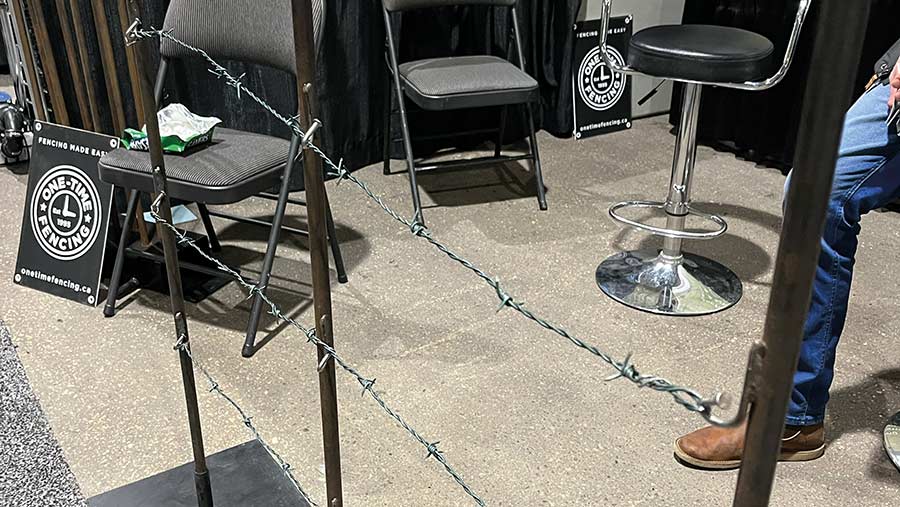
© MAG/Oliver Mark
Construction of the fence involves bashing the rods into the ground and hooking the wire – barbed, plain or net – to the nails. A Stillson is then used to twist them, thus tightening the line.
To restrain bigger, stronger beasts than your average flock of Swaledales, the firm offers bison-spec 8ft posts.
These have a 7/8in diameter, compared with the 3/4in of the standard 6ft version, and wider-spaced wire hooks.
According to the company, the steel fence system “will do anything a wood fence will, except rot and burn.”
A 6ft post is priced at C$8.50 (£5.40).
Intelligent Ag’s Recon Spraysense
Arable farmers craving more technology, rather than greater capacity, no longer need to shell out on a new sprayer at vast cost, says North Dakota-based Intelligent Ag.
Its retrofit Spray Sense system uses sensors attached to each nozzle body that track pressure, flow and droplet size and relay the information to an iPad-based app in the cab.
This data is translated into a spray quality index, notifying the operator of any partial blockages or worn/expanded orifices that might be reducing the accuracy of applications and efficacy of the chemical.
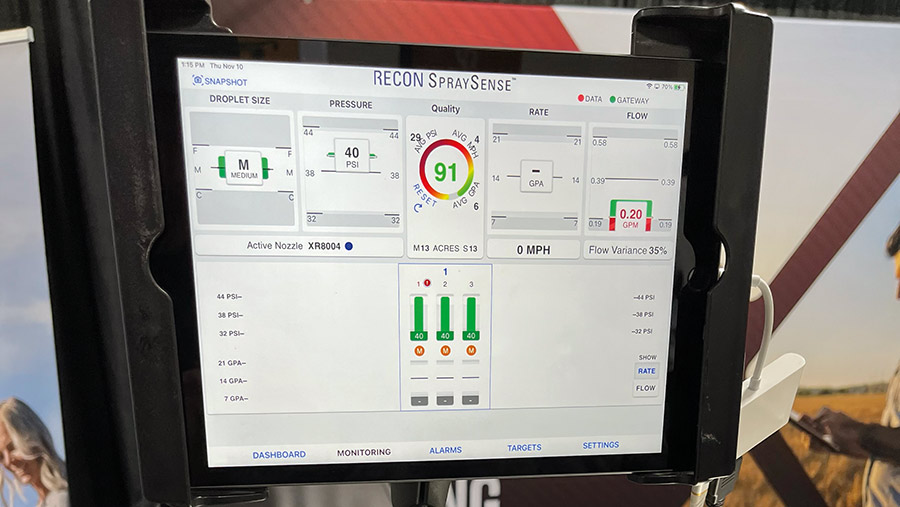
© MAG/Oliver Mark
Prior to starting, operators must configure the system by entering the nozzle type and size, plus their target travel speed and the pressure range in which they aim to work.
It is currently only compatible with Hypro standard flow nozzles bodies, but other versions are coming soon.
A 36m kit costs C$20,000 (£12,700).
Onecup AI
Facial recognition may be the scourge of anti-establishment Londoners, but another manifestation of this Big Brother technology has been adapted for a very different use in the Albertan countryside.
Onecup AI’s Betsy (Bovine Expert Tracking and Surveillance) system uses a combination of cameras, computer vision and artificial intelligence to identify animals by their appearance and monitor their activity – without the need for a tag or collar.
This concept, which is an extension of the basic surveillance camera setups employed by farmers in the UK for monitoring lambing or calving, offers owners far more insight into the wellness of their herd or flock.
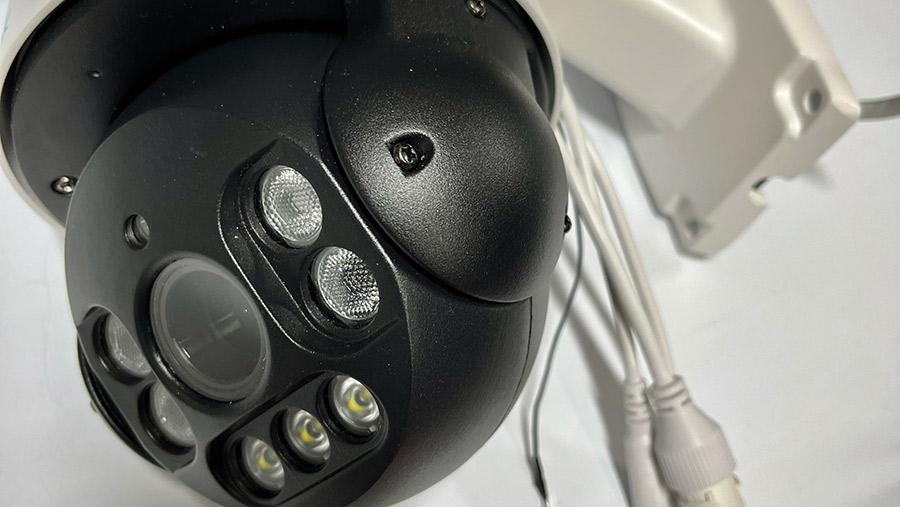
© MAG/Oliver Mark
Camera mounts
The cameras – several of which are required to get a good view of an area – can be mounted wherever cattle congregate, such as a water trough, salt lick or feeding station.
These can apparently identify an animal from any angle and from a reasonable distance, monitoring its behaviour to form a benchmark dataset to compare to in the future.
This means the system can detect anything out of the ordinary, alerting farmers to an imminent calving or apparent health issues such as lameness, coughing, an arched back or depression.
It also observes the frequency of visits to a feed or water trough and tracks animal activity and growth, including how much time it spends walking, laying and sleeping.
The ruck of data on each animal, and the herd as a whole, can be viewed online, giving farmers an opportunity to assess overall performance and the effect of variables such as weather or feed quality.
Setup involves fitting several cameras, upgrading the farm’s wifi to support the Betsy system, and signing up to the firm’s online herd management platform.
Duckfoot
Nothing tests a combine driver’s patience quite like trying to feed in a laid crop, though the battle could be swung in the operator’s favour with a set of Duckfoot paddles.
They were designed by Saskatchewan grower Steve Kastning, who was dealing with exactly that challenge when cutting lentils and lodged cereals.
His natty solution – a set of clip-on plastic paddles – slips straight over the combine’s standard metal reel tines.
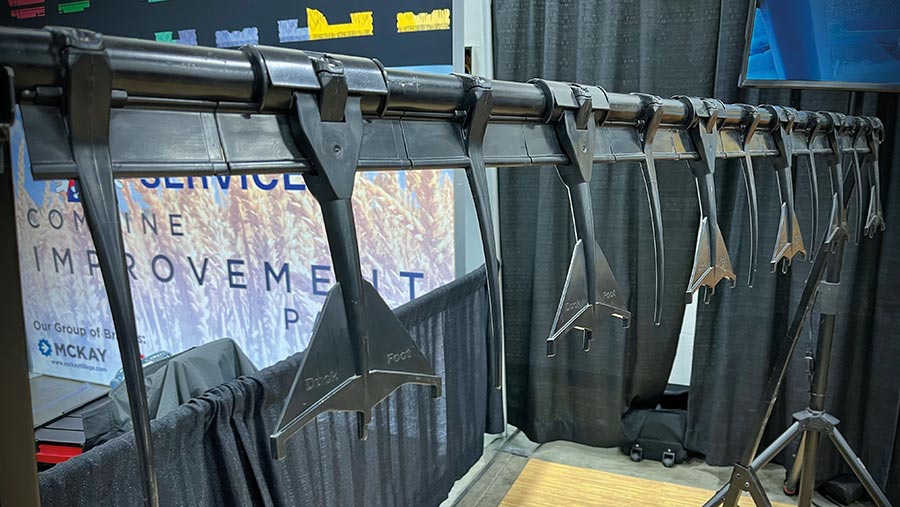
© MAG/Oliver Mark
They’re designed to be mounted on alternate fingers, with their greater surface area helping to bite into the crop and drag it onto the header table.
This potentially allows the combine’s forward speed to be upped by more than 0.5mph and the reel slowed down.
And because they are made of heavy-duty plastic, they should snap before the tine does – eliminating the risk of sending metal through the combine’s innards.
That said, Duckfoot says some of its earliest versions are still going strong after 20,000ha.
They cost C$15/paddle (£9.50), can be ordered direct to the UK from the Duckfoot website, and are compatible with all combine header brands.
Flexxifinger Multicrop Valve
Multicropping – the process of sowing two crops with similar maturation dates together in the same field – can now be simplified by Flexxifinger’s Multicrop Valve.
It allows a standard, split-tank pneumatic drill to be quickly converted into one capable of applying different seed types in different rows.
Rather than connecting and disconnecting pipework to alter the row configuration for each field, Flexxifinger’s Y-shaped junction is permanently fitted to the drill.
It receives feeds from two different input pipes (one from each tank), both of which have knife gates to open and close them – allowing operators to select which crop type is sown behind each opener.
This is particularly handy when experimenting with different row formats, such as two of rapeseed followed by one of peas.
It can also quickly be converted back to a conventional layout for monocropping, simply by opening the necessary knife gates.
Each valve costs C$130 (£82).
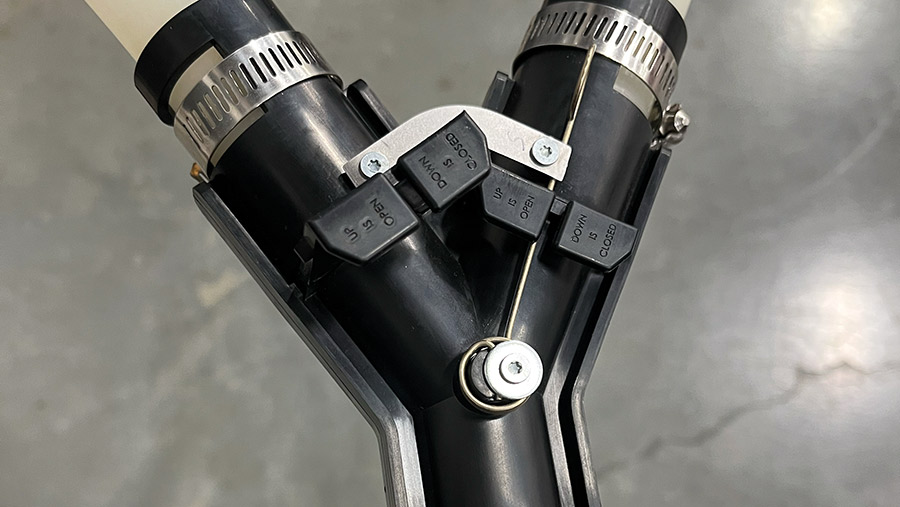
© MAG/Oliver Mark
Flexxiselect
The Saskatchewan-based firm is also broadening its range of attachments for relay cropping, which involves pairing two crops with different maturation dates, such as wheat and soya beans.
With the latter still in the ground and actively growing, harvesting the wheat is a more delicate process.
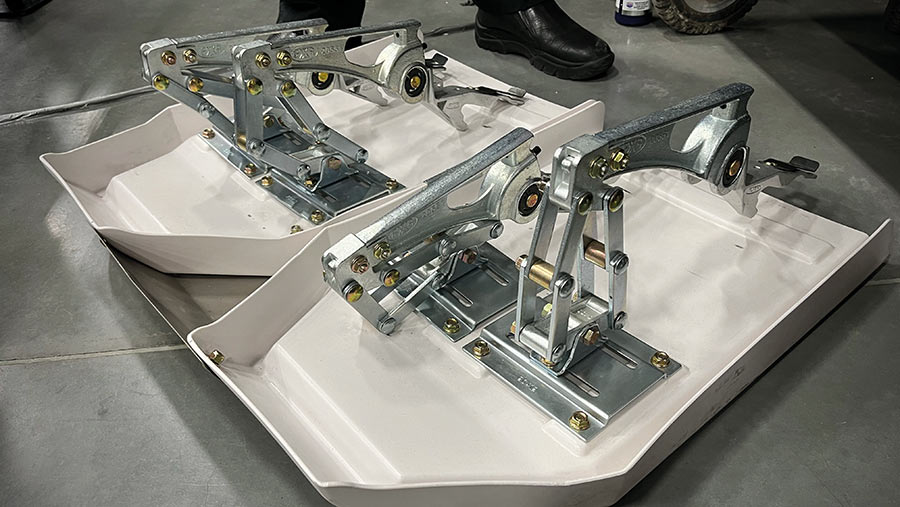
© MAG/Oliver Mark
For this, the company offers its Flexxiselect skids, which mount to the crop lifters on the header cutterbar to ensure it glides over the soya bean rows without damaging the plants.
The skids are available in 10in (254mm), 16in (406mm) and 20in (508) widths and are installed at intervals to suit the row spacings of the wheat.
They can also be combined to broaden the range of configurations, such as wheat rows at 60in (1.52m) centres with three soya bean rows between.
Each unit costs C$1,000 (£635).
Seedmaster Ultra SR
Though gargantuan in size, Seedmaster’s new Ultra SR drill demonstrates a single-row coulter layout that could be replicated on a smaller scale for UK farms.
This unusual configuration makes the implement far shorter, lighter and more manoeuvrable than one with its soil-engaging components spread across three rows.
The other perk, says Seedmaster, is that seed and fertiliser is placed more accurately, because there’s no risk of a front row of openers throwing material into the path of those that follow and interfering with their depth control in the process.
As a result, the company says working speed can be up to 3kph quicker.
The challenge is maintaining a steady flow of trash, though that has apparently been solved by the inclusion of ground-driven, steel-spoked wheels mounted between the openers to pull the material through.
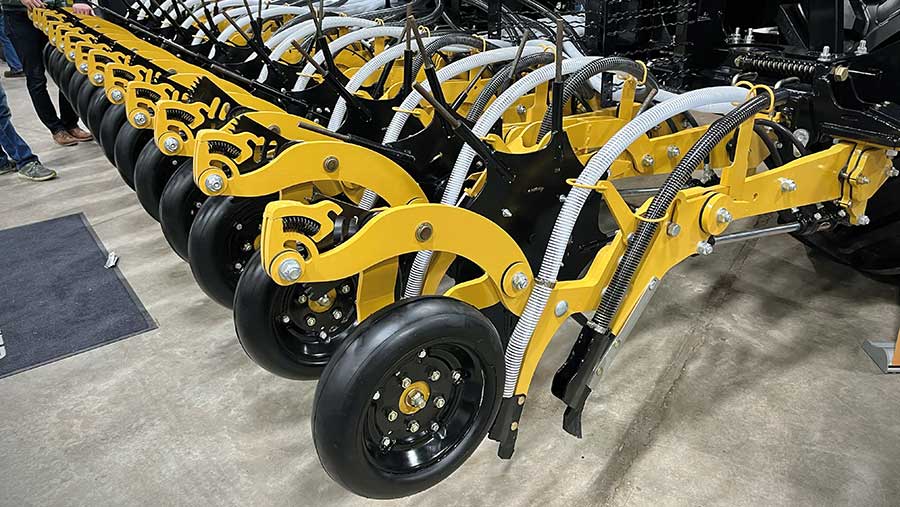
© MAG/Oliver Mark
And to eliminate the risk of hair-pinning, the Ultra SR gets dual knife openers, with fertiliser deposited 40mm to the side and 18mm deeper than the seed.
However, the single-rank format means rows are spaced at 15in (380mm).
Though Seedmaster reckons this can benefit rapeseed, it is less suited to cereal crops and some farmers running early iterations of the Ultra SR have reported slight drops in wheat yield.
Seed and fertiliser are carried in two hoppers totalling about 20t capacity.
There are no distribution heads, with the product instead piped directly from the electric metering units at the base of the tanks to the outlets behind the openers.
This arrangement allows for turn compensation, is gentler on the seed and has apparently improved accuracy to within 5% of the target rate, versus closer to 20% with a standard system.
The 60ft (18.3m) model on show is a match for a tractor of at least 400hp and – brace yourself – costs C$600,000 (£380,000).
Tridekon Cropsavers
Growers opting not to put tramlines in with the drill, or those running chunkier sprayer tyres year-round, can minimise trampling with Tridekon’s Cropsavers.
The stainless-steel cones divide the crop ahead of each wheel to minimise damage and reduce the number of unripe plants in the wheelings at harvest.
They are either bolted or welded to the main frame, depending on the sprayer model, and come with quick-attach hooks that allow the 90kg cones to be fitted or removed in a matter of minutes.
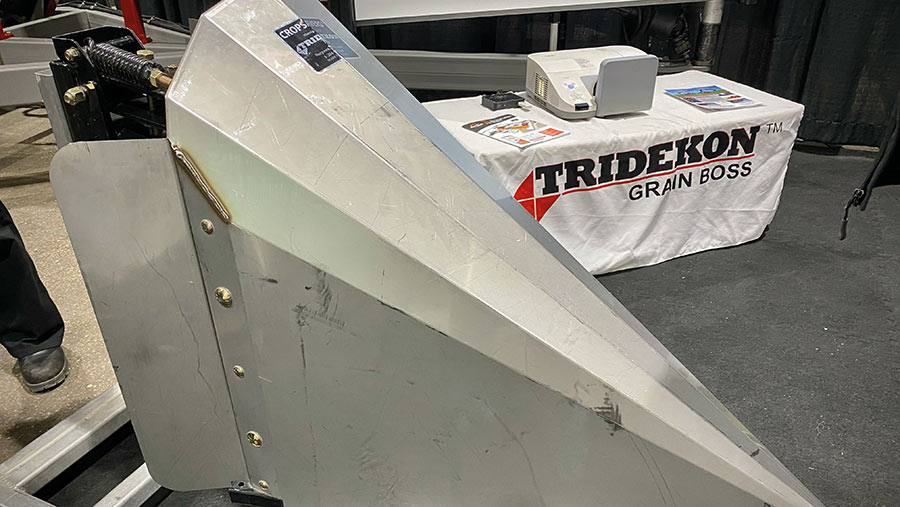
© MAG/Oliver Mark
A floating parallel linkage with adjustable spring tension provides an element of suspension on each unit, and their height can be altered to match the crop growth stage.
The company recommends fitting them to all four wheels of a self-propelled sprayer, as the crop waves back into place as it passes and the canopy needs reopening to avoid trampling.
They can also be used for trailed machines, with one pair mounted ahead of the sprayer’s wheels and a second set fitted to the front of the tractor.
Options include a widening kit for bigger wheels and deflector arms to guide the crop past the tyres. There’s also a pneumatic system controlled from the cab that allows the cones to be lifted by up to 90cm.
The Cropsavers are available for most sprayer brands in North America, and several European models, including the Fendt Rogator and Agrifac Condor. A top-spec kit for the latter costs about C$10,000 (£6,355).
Other news from North America
Trimble invests in autonomous machinery
Trimble has expanded its range of spot-spraying equipment with the acquisition of French start-up Bilberry.
This will broaden the guidance specialist’s offering beyond the Weedseeker, an infrared sensor-based system for targeting weeds on stubbles, which it acquired from Californian firm NTech in 2009.
Bilberry was one of the first companies to develop the artificial intelligence software required to detect and spray weeds in a growing crop.
For this, it fits cameras at 3m intervals along the sprayer boom, each paired with a processor that sends data to a computer in the cab that, in turn, initiates the opening/closing of the nozzles.

© Kubota
Trimble has also made sizeable investments in Monarch Tractor, which builds autonomous electric compact tractors at its plant in Lordstown, Ohio, and Chicago-based contracting firm Sabanto.
The latter runs a fleet of sub-100hp Kubota tractors (pictured left) that are adapted for autonomous operation using off-the-shelf components, including a dual-antenna GPS receiver, hydraulic steering valve and connection to an RTK network.
By tapping into the Canbus wiring system, Sabanto is able to operate the tractors remotely and view information such as speed, fuel use and linkage position without anyone sat on the seat.
Hydrogen power for Versatile tractors
A hydrogen-powered Cummins engine could feature in future Versatile tractors, according to Canadian publication The Western Producer.
Cummins has a working prototype of a 6.7-litre gas-fuelled combustion engine, and its monster 15-litre unit could be ripe for conversion, too.
As with JCB’s version, the block is likely to be very similar to the diesel from the head gasket downwards, meaning most of the components will remain unchanged.
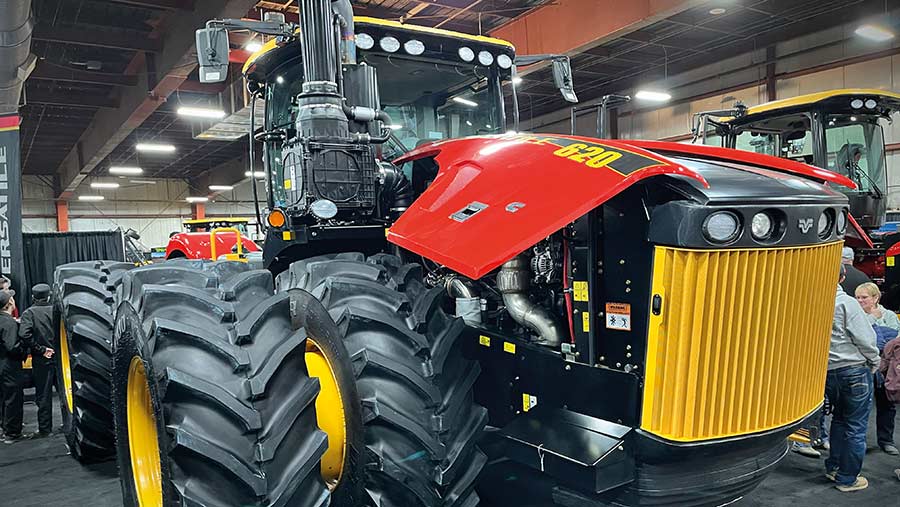
© MAG/Oliver Mark
The most significant alterations are to the turbo, fuel delivery (spark plugs rather than compression ignition) and exhaust systems.
However, production is still a long way off, with Cummins currently focusing on extracting the same horsepower as an equivalent diesel finding a way to meet the engine’s cooling requirements.
Work also needs to be done on developing and fitting the high-compression tanks required to store the hydrogen gas on the tractor.
Case IH and New Holland demo driverless tractors
CNHi’s US$2.1b acquisition of Raven Industries is already bearing fruit, with Case IH and New Holland both adapting the firm’s technology to produce driverless tractors.
The kit, which was originally developed by Iowan start-up Smart Ag and dubbed the AutoCart, allows a combine operator to summon the vacant tractor and chaser bin when it is ready to unload, controlling its speed via a tablet in the cab.
Using a combination of mapped field boundaries, GPS data from the combine and a sophisticated perception system, the tractor is able to avoid obstacles, keep clear of standing crop and drive itself to a predetermined location ready to empty into a waiting bulker.
Raven’s Autonomy system has also been fitted to a self-propelled Case IH Trident 5550 fertiliser spreader, which was unveiled at the Farm Progress Show in Boone, Iowa, earlier this year.
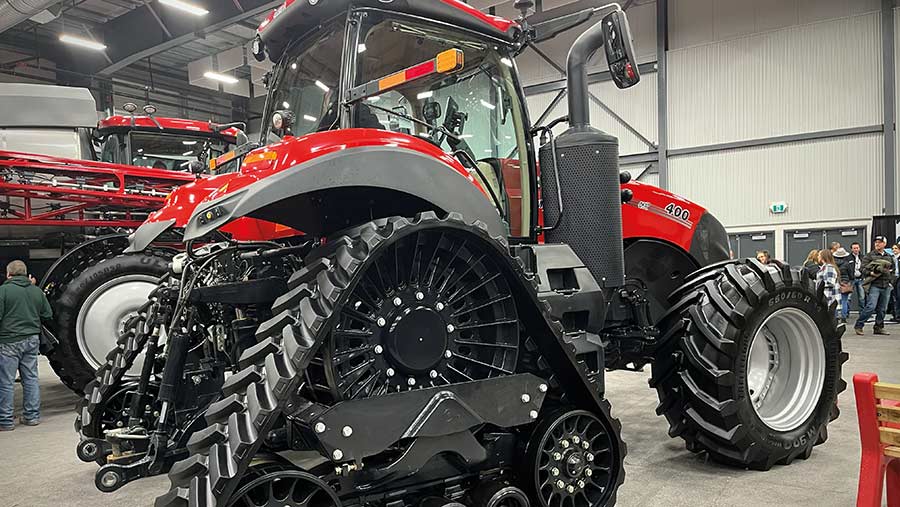
© MAG/Oliver Mark
It’s an extension of the software originally developed for the OmniPower driverless tractor platform (previously known as Seedmaster’s Dot), allowing the Trident to plan and complete a route based on a mapped field boundary.
Work can be initiated using a mobile device, from which operators can monitor fuel level, forward speed, engine rpm, remaining load and any fault codes.
Cameras and radar sensors detect obstructions, a horn sounds prior to driving, geofences prevent it crossing boundaries and there is a remote kill switch.
Plus it still has a cab, so it can be driven conventionally between field and yard.
Though the technology is still in its infancy, and regulations regarding autonomous machinery remain foggy, Case IH believes it could start deliveries of the driverless Trident by the end of next year.

